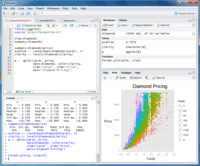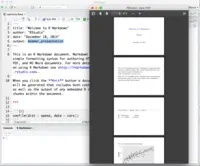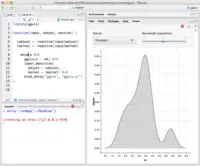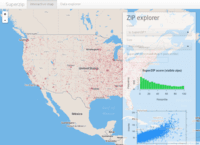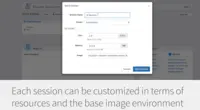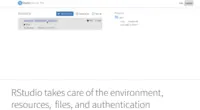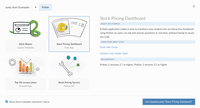Overview
What is Posit?
Posit, formerly RStudio, is a modular data science platform, combining open source and commercial products.
Posit, the Best ever Data Science Software
All-in with RStudio
Everything you need in data science
Great Product for Data Analysis
RStudio for Business Analysis
Rstudio - The most convenient ML tool
My very personal RStudio R&D journey
There is no WORK without R and no R without RStudio
RStudio Connect(s) your data science products to your clients.
RStudio is great but needs some improvements
RStudio from a Grad Student's POV
RStudio analytics perspective for product reporting
Best FOSS (Free and Open Source Software) in the market for Statistical analysis
RStudio: An all-purpose way to interact with R
Everyday Statistical Workbench
Awards
Products that are considered exceptional by their customers based on a variety of criteria win TrustRadius awards. Learn more about the types of TrustRadius awards to make the best purchase decision. More about TrustRadius Awards
Popular Features
- Visualization (26)8.484%
- Connect to Multiple Data Sources (25)8.181%
- Extend Existing Data Sources (26)7.474%
- Automatic Data Format Detection (25)6.363%
Reviewer Pros & Cons
Video Reviews
2 videos
Pricing
What is Posit?
Posit, formerly RStudio, is a modular data science platform, combining open source and commercial products.
Entry-level set up fee?
- Setup fee optional
Offerings
- Free Trial
- Free/Freemium Version
- Premium Consulting/Integration Services
Would you like us to let the vendor know that you want pricing?
11 people also want pricing
Alternatives Pricing
What is MATLAB?
MatLab is a predictive analytics and computing platform based on a proprietary programming language. MatLab is used across industry and academia.
What is Rational BI?
Rational BI provides analytics, data science and business intelligence in an analytical platform that connects to databases, data files and cloud drives including AWS and Azure data sources, enabling users to explore and visualize data. Users can build real-time notebook-style reports directly in a…
Product Demos
What is Posit Workbench? Build Data Products in R & Python using Jupyter, VSCode, and RStudio.
Posit Connect | Host all of the data products you create
Features
Platform Connectivity
Ability to connect to a wide variety of data sources
- 8.1Connect to Multiple Data Sources(25) Ratings
Ability to connect to a wide variety of data sources including data lakes or data warehouses for data ingestion
- 7.4Extend Existing Data Sources(26) Ratings
Use R or Python to create custom connectors for any APIs or databases
- 6.3Automatic Data Format Detection(25) Ratings
Automatic detection of data formats and schemas
Data Exploration
Ability to explore data and develop insights
- 8.4Visualization(26) Ratings
The product’s support and tooling for analysis and visualization of data.
- 8.3Interactive Data Analysis(23) Ratings
Ability to analyze data interactively using Python or R Notebooks
Data Preparation
Ability to prepare data for analysis
- 8.1Interactive Data Cleaning and Enrichment(23) Ratings
Access to visual processors for data wrangling
- 8.3Data Transformations(25) Ratings
Use visual tools for standard transformations
Platform Data Modeling
Building predictive data models
- 8.2Multiple Model Development Languages and Tools(21) Ratings
Access to multiple popular languages, tools, and packages such as R, Python, SAS, Jupyter, RStudio, etc.
- 8.4Single platform for multiple model development(21) Ratings
Single place to build, validate, deliver, and monitor many different models
- 8Self-Service Model Delivery(18) Ratings
Multiple model delivery modes to comply with existing workflows
Model Deployment
Tools for deploying models into production
- 8.4Flexible Model Publishing Options(17) Ratings
Publish models as REST APIs, hosted interactive web apps or as scheduled jobs for generating reports or running ETL tasks.
- 8.9Security, Governance, and Cost Controls(15) Ratings
Built-in controls to mitigate compliance and audit risk with user activity tracking
Product Details
- About
- Integrations
- Competitors
- Tech Details
- FAQs
What is Posit?
Posit, formerly RStudio, provides a modular data science platform that combines open-source and commercial products.
their open source offerings, such as the RStudio IDE, Shiny Server, rmarkdown and the many packages in the tidyverse, boast users among data scientists around the world to enhance the production and consumption of knowledge by everyone, regardless of economic means.
Their commercial software products, including Posit Workbench, Posit Connect, and Posit Package Manager, are available as a bundle in Posit Team. These products aim to give organizations the confidence to adopt R, Python and other open-source data science software at scale. This enables data science teams using R and Python to deliver interactive reports and applications to decision-makers, leverage large amounts of data, integrate with existing enterprise systems, platforms, and processes, and be compliant with security practices and standards.
The platform is complemented by online services, including Posit Cloud and shinyapps.io, to make it easier to do, teach and learn data science, and share data science insights with others, over the web.
Posit’s open-source software and commercial software form what the vendor describes as a virtuous cycle: The adoption of open-source data science software at scale in organizations creates demand for Posit’s commercial software; and the revenue from commercial software, in turn, enables deeper investment in the open-source software that benefits everyone.
Posit Features
Platform Connectivity Features
- Supported: Connect to Multiple Data Sources
- Supported: Extend Existing Data Sources
- Supported: Automatic Data Format Detection
Data Exploration Features
- Supported: Visualization
- Supported: Interactive Data Analysis
Data Preparation Features
- Supported: Interactive Data Cleaning and Enrichment
- Supported: Data Transformations
Platform Data Modeling Features
- Supported: Multiple Model Development Languages and Tools
- Supported: Single platform for multiple model development
- Supported: Self-Service Model Delivery
Model Deployment Features
- Supported: Flexible Model Publishing Options
- Supported: Security, Governance, and Cost Controls
Additional Features
- Supported: Share Data Science insights in the form of Shiny applications, Quarto content, R Markdown reports, Plumber APIs, dashboards, Jupyter Notebooks, and interactive Python content.
Posit Screenshots
Posit Videos
Posit Integrations
- Amazon SageMaker
- Kubernetes
- Apache Spark
- Jupyter Notebook
- Streamlit
- Tableau Desktop
- Azure Machine Learning
- Databricks Lakehouse Platform
- Microsoft Visual Studio Code
- Bokeh
- Slurm
- Dash applications
- SAML Marketplaces
Posit Competitors
Posit Technical Details
| Deployment Types | On-premise, Software as a Service (SaaS), Cloud, or Web-Based |
|---|---|
| Operating Systems | Windows, Linux, Mac |
| Mobile Application | No |
Frequently Asked Questions
Comparisons
Compare with
Reviews and Ratings
(237)Community Insights
- Pros
- Cons
- Recommendations
Intuitive User Interface: Users have found RStudio to have an intuitive user interface that allows them to quickly test and debug code. This has been mentioned by numerous reviewers, highlighting the ease of use and convenience it offers in coding tasks.
Seamless Integration with Git: The seamless integration of RStudio with Git has been praised by users, making it easy for them to manage version control. Several reviewers have specifically mentioned this as a major advantage of using RStudio for their coding projects.
Powerful Statistical Analysis Tool: Many users appreciate RStudio's capabilities as a powerful tool for statistical analysis and data exploration. They mention its ability to import data from multiple sources, apply machine learning models easily, and export data into various channels.
Confusing and Outdated User Interface: Several users have expressed dissatisfaction with the user interface of RStudio, finding it confusing, unattractive, and outdated compared to other tools. They feel that the interface is too technical for business people.
Frequent Crashes with Large Datasets: Some users have mentioned that RStudio frequently crashes when loading large amounts of data. This can be frustrating and disrupt their workflow.
Lack of Integration with Other Applications: Users have pointed out that RStudio is not as integrated with other applications as Python. This limitation makes it less convenient for users who rely on seamless integration between different software tools.
Users commonly recommend RStudio for beginners in R programming and data analytics. They believe that RStudio is a good tool for learning machine learning and recommend using it for data work, programming R code for machine learning, implementing R software, data analysis, and data science. Users consider RStudio to be a great resource for analyzing data and necessary for anyone who wants to get into R programming. While considering other suites and languages like Python, they still recommend taking a look at RStudio for data analysis. Additionally, users find RStudio to be useful for doing statistics and creating professional plots and figures. They suggest familiarizing oneself with common libraries in the field and doing online tutorials before starting to use RStudio. Users warn about the steep learning curve but believe it is worth investing the time to learn it. Moreover, they recommend using RStudio for big data and epidemiological research.
Attribute Ratings
Reviews
(1-25 of 77)Posit, the Best ever Data Science Software
Business problems like patient analytics, feasibility studies are done using Posit Workbench. Based on clients' requirements and requests we use RStudio and R packages for data visualization including Bar plots, Line Plots for various kind of statistical analysis viz. Correlation analysis, LASSO regression, Elasso or Network analysis and Graph.
We have used RStudio for parallel computing with the R package VSURF to handle big data like millions of rows and columns (mostly patient churn and history data). We also used ggplot2 and plotly library for stunning graphs and plots.
Last but not the least, we have used Rmarkdown (or now Quarto) for generating PDF, Word reports to clients for data validation and case studies according to business requirements.
- Efficient coding
- Clean IDE
- Help page and large community
- Data view support for all kinds of data formats
- More organized help page
- Installation packages of older version as well as latest one
Based on my experience, I use Posit software aka RStudio Pro and Posit Workbench for almost everything in our company as well as clients network. From data preparation to statistical and predictive model building, I use RStudio Pro exclusively. In addition to this, data visualization and data manipulation are also done by Posit software.
I have used multiple R packages for various kind of data analysis from logistic regression, classification to LASSO and elasso (Network Analysis).
Only one scenario I would like to say that it is less appropriate is to view the data of formats other than data frame. I really wish to see this issue will be solved in the next major updates of Posit.
Overall Posit is really a good software and platform for any kind of data analysis and visualizations. Thanks.
All-in with RStudio
- RStudio provides an integrated product suite for both model development and deployment to end users.
- RStudio provides an open-source version of its products to ensure accessibility to all users
- The RStudio Connect (Shiny) platform is an incredible tool for quickly making statistical models, documents, apis, and enriched data available to end users.
- RStudio could consider an archetype tool within the RStudio IDE. This would be similar to a Maven archetype, where the user identifies the type of work they are doing and the tool would generate a series of directories and the project scaffolding (based on best practices) to springboard a larger project.
- It would be nice to see the files in a directory tree similar to Intellij. This would prevent the constant drilling in and out of directories in a larger project.
RStudio for Business Analysis
- Visualization tool
- Statistical Analysis
- Forecasting
- More flexibility to import tamplates for the visuals
- More documentation about the formulas
- More coding automation
Rstudio - The most convenient ML tool
- Data processing
- Data visualization
- Machine learning
- Tool development (Rshiny)
- User interface
My very personal RStudio R&D journey
- RShiny applications that are intuitive and help to communicate in the multidisciplinary teams
- d3.js based visualizations
- Bayesian statistics
- calculating confidence intervals
- merging tables by using SQL commands
- using regular expressions
- some of the machine learning implementations are best in R
- way more hassle-free than SAS, in my opinion
- open-source - RStudio does not discriminate against people & businesses based on their financial status, many small businesses cannot afford SAS, in many developing countries young people are willing to learn to program, and SAS platforms or other paid software is absolutely out of the question, those people/young programmers will be not able to afford even free cloud SAS due to the internet infrastructure...some of the best ideas come from those who face serious challenges in life and can speak several languages as their minds are often more creative ("necessity is the mother of invention"). I feel that platforms like RStudio or Jupyter connect me with the World, with other creative minds, and contribute to making the World a fairer, better place.
- something like IronPython in Spotfire, but R equivalent would be great; the existing R interface is not fully functioning
- something like Pyhon interface in Stata, but R equivalent would be awesome
- in the pharma World deadlines are tight, pressure is very high - Stata lets manipulate data super fast compared to R
- brining R and Python community together
- in my opinion, Natural Language Processing pipelines are better than in R
- catching up with some of the machine learning implementations - visualization aids in this field are better in Python, at least that is my intuition
- Deliver data/insights to customers
- Multi-language (R, Python)
- Empower staff
- The name causes people to incorrectly think it is an R-focused product. It isn't.
RStudio is great but needs some improvements
- Data cleaning
- Statistical packages
- Machine learning algorithms
- Installation process is a bit confusing
- Steep learning curve for non technical person
- Better UI
RStudio analytics perspective for product reporting
- Easy installation of library of requisite drivers
- Great for statistical analysis
- Quick querying and custom analysis to drill down
- Better inbuilt training to decrease reliance on external resources
- Parity for Mac and PC users, provide same set of features
- Bundle R so that it doesn't have to be installed separately
- Programmable
- Repeatable workflow
- Consumes very less resources
- Statistical analysis
- Data cleansing
- Data visualization
- Modelling
- Though the UI is far better than other IDEs available in the market yet, it looks more like an old DOS machine.
- Packages. They are all over the place as there are no evident categories in which they can be arranged. So unless you know the name of the Package, it's really hard to get your hands on it.
- A little overwhelming. At least for someone who comes from a low coding platform. Although the community is pretty strong.
A couple of chinks in RStudio armor are very small and can be considered as nagging just for the sake of argument. Other than completely based on programming language, I couldn't find significant drawbacks to using RStudio. It is one of the best free software available in the market at present.
Everyday Statistical Workbench
- Data visualization
- Big data
- Statistical modeling
- R
- Python
- Web sites
- Databricks
- Azure DevOps
RStudio - Very Powerful Statistical Tool
With the shiny apps, we are automating routine excel reports which saves a lot of time for database and business analysts.
We have written numerous algorithms in RStudio like Naive Bayesian Classification, K-Means Clustering and ARIMA modelling.
RStudio is an amazing platform for statistical data analysis.
- Performing Statistical Analysis is very efficient. With a lot of open source packages available in R programming, data analysis becomes very easy.
- Publishing web applications and deploying predictive data models is very easy if you have R Server in your firm using Shiny. It can handle large sets of data.
- Writing data science algorithms like Clustering, Classification and Apriori Analysis is very efficient. The open source nature of this programming language allows everyone to contribute packages to the environment.
- There are some packages in RStudio which aren't very well known hence its very difficult to get help if you get stuck using them.
- If the dataset size crosses 20 million rows, then you need extremely high RAM otherwise the processing gets very slow. So in such a case R Server is a must. Cloud storage can be a good alternative though.
- The graphs which are plotted in the console aren't very intuitive and labels, colors, axis, etc have to be manually written to make the visuals look more appeasing.
In a situation where you want to automate excel reports then shiny (user interface for R) comes in very handy.
Enhancing Data science capabilities with RStudio
- Dara Management.
- Descriptive and Statistical analysis.
- Data science and machine learning.
- Text analysis.
- Can not run concurrent sessions and sometimes freezes but can be due to local or virtual machine capacity.
- RStudio has come a long way, and expect enhancements will continue to improve performance and ease to use.
- The support is incredibly professional and helpful, and they often go out of their way to help me when something doesn't work.
- The one-click publishing from RStudio Connect is absolutely amazing, and I really like the way that it deploys your exact package versions, because otherwise, you can get in a terrible mess.
- Python doesn't feel quite as native as R at the moment but I have definitely deployed stuff in R and Python that works beautifully which is really nice indeed.
- I'm only a data scientist, I'm not DevOps, but I did find RStudio Connect hard to install. I have also tried and failed to get proxy authentication with Apache working, I'm sure it's me being thick but I have never gotten there with it.
- Another thing I don't like is some of the abstractions in RStudio Connect. There isn't really a file system at all, and data refresh is done with a scheduled RMarkdown report, which is okay but it's a bit round the houses and it's very different from the code on my local machine.
- I don't love the pricing model of RStudio Connect where you pay just as much for publishers as you do for consumers. I wish we could have, say, 5 publishers and more consumers on our current licence.
RStudio - a cheap and effective statistics program
- Quantitative analyses.
- Descriptive analyses.
- Graphs.
- The point and click functions of the program could be better.
- Updating the program could be an easier process.
- Other programs make it easier to read in data.
RStudio - Perfect for the Low Budget Statistician
- Descriptive analyses.
- Predictive analyses.
- Accessing data.
- Replicating syntax.
- The interface.
- A more beginner-friendly walkthrough.
- Have also had issues with program versions impacting syntax execution.
RStudio is wonderful!
- Automate processes
- Statistical Analyses
- Portable Code
- A very good IDE for R programming
- Can be intimidating to non-programmers
- I wish I could copy data to the clipboard easier
- I never have a big enough screen to see all of the data I want to see
A must have tool for data analysts
- It's super quick.
- It has inbuilt functions for most of the analytics procedures.
- It has great visualizations.
- It has lots of libraries and sometimes it shows errors while importing them.
- Its UI can be improved.
- It takes a lot of time exporting files.
RStudio Is the Best R GUI for any price, let alone free!
- Troubleshooting of Code.
- Color Coding of different elements of code.
- Adding new packages.
- Infinitely customizable.
- Better Resource Analysis.
- Better progress bars.
- Debugging could use a little improvement.
An almost one-stop shop for your analytics needs
- Keyboard shortcuts
- Integrating multiple programming languages
- Providing creators with the resources to develop gold-standard packages
- I have never been able to successfully replace my SQL editor with RStudio since the SQL drivers are so hard to set up. I would eventually love to be able to use RStudio as a one-stop-shop.
RStudio for R!
Through the products - e.g., web app, API, reports - that were built using the publishing platform (RStudio Connect), every users in the company were able to access analytics applications designed specifically for individual use cases.
- Integration with databases.
- User community.
- Integration with other software/languages.
- Lacks stability.
- Memory management.
As RStudio continues to expand its adoption of other languages and IDE - e.g., Python, VS Code - and leverages its seamless develop-test-deploy workflow, the platform is suitable for analytics team who desire full control and flexibility of product development with little overhead when publishing to production.
RStudio: Difficult Learning Curve with Matching Pay Off
- Data Organization
- Multi-Linear Regression
- Data Visualization
- Time-Series Forecasting
- As a scripting language, it is not a pick up and go platform. You need to spend the time to learning the program.
- Platform versions and Package versions often do not align.
- Would love to see standard templates that would generate a basic code for statistical models. This could save time and help newer users learn how to operate the program.
This is NOT a pick up and go platform as we are used to. It has hundreds of advantages and can be customized to near perfection. Yet, it will require many hours of investment. I would suggest looking at other pre-built platforms if the team is smaller.
RStudio for quick prediction prototyping
- We use it for a quick visual representation of data
- We do exploratory data analysis to understand data
- We do predictions using RStudio
- When we have to run 100 iterations using more than 10000 records, RStudio gets stuck or takes a very very long time to respond
- Generating a pdf report from an RMD file is very difficult from RStudio.
- Generating a pdf report in RStudio cloud is straightforward and inbuilt.
RStudio - Dire wolf of "Game of Data Science"
- Abundant development on statistical and data science libraries.
- Interaction with other programming languages and BI tools.
- Customized application building and reporting framework through shiny and markdown.
- Simple IDE with competent and robust functionalities.
- Strong and active community.
- Highly approachable core members and teams @Rstudio.
- Integration with Google Cloud Platform.
- Flexibility of choosing a remote R-interpreter (as is present in IntelliJ/PyCharm).
- Memory issues and slowdowns when it comes to working with large datasets.
- Orchestration of production workflows with Airflow.
- Production pipelines for RStudio Connect content.
RStudio is the Swiss Army knife of R Solutions
- Excellent integration of both R and Python IDEs in one.
- Simple publishing of dashboards and applications from RStudio IDE to RStudio Connect.
- Integration of package management with projects to support collaboration.
- Excellent contributors to the R Open Source community, really invested in its health.
- Support integration with Enterprise AD environments for security.
- Python integration is newer and still can be rough, especially with when using virtual environments.
- RStudio Connect pricing feels very department focused, not quite an enterprise perspective.
- Some of the RStudio packages don't follow conventional development guidelines (API breaking changes with minor version numbers) which can make supporting larger projects over longer timeframes difficult.
RStudio helps data scientists get things done faster
We help our colleagues to better understand the financial health of the company through profit and loss evaluation, risk underwriting and portfolio review. RStudio helps us bridge the gap between Data and Solution, we tell story through data visualization and reproducible analytical documents that are easy to grasp by our colleagues.
- Great selection of libraries to do statistics, machine learning, data visualization, interactive dashboards
- RStudio Connect makes sharing your work with your colleague a breeze using one-click publishing.
- The ability to connect R with other languages like Julia and Python all within the same working session helps generate more creative ways to solve problems. We can use Julia in R to speed up intensive calculation, or we can use Python Tensorflow or Pytorch in R to do deep learning.
- R has a great community on social media and stackoverflow so it's very easy to learn from the other users.
- The learning curve may be a little steep for new R users
- There are multiple ways to solve a problem. For example, there are mlr3 and tidymodels to build predictive models, and there are tidyverse and data.table to perform data cleaning. It could be confusing and overwhelming for new users to decide which libraries to learn and use.
R is single-threaded, so it may not be suitable when you need to scale your application to many users. For example, if you have a shiny app with R, the performance may slow down when multiple users are in the app. People are addressing this issue in several ways, however, so this may not be a deal-breaker.


